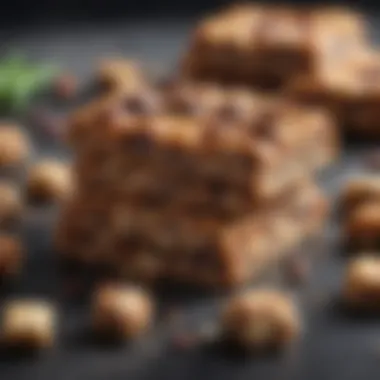Keto Trail Food: A Comprehensive Guide


Intro
Embarking on a trail adventure while adhering to a ketogenic lifestyle can seem like steering a ship through uncharted waters. With the right preparation and knowledge, however, it’s not only possible but can also be profoundly satisfying. This guide aims to spotlight the intersection of tasty trail food and the keto diet, ensuring that outdoor enthusiasts can enjoy their adventures without compromising their dietary goals.
The beauty of keto trail food lies in its simplicity and flexibility. By prioritizing high-fat, low-carb ingredients, one can unlock a treasure full of nutrient-dense meals and snacks. As we traverse this guide, we will cover essential facets such as nutritional benefits, meal preparation strategies, and clever snacking ideas. Each section will arm you with the know-how necessary to select, pack, and enjoy delectable meals that suit your ketogenic lifestyle on the go.
Expect to gather insights on how to maintain ketosis on long excursions and discover recipes that both delight the palate and satisfy hunger. Whether you’re hiking a remote wilderness trail or simply enjoying a weekend in your local park, the right keto foods can make all the difference.
Let’s kick things off by highlighting one dazzling recipe that exemplifies the joy of keto trail eating.
Recipe Highlight
Keto Avocado Tuna Salad
This Keto Avocado Tuna Salad combines healthy fats and protein, perfect for refueling during an outdoor outing.
Essential Ingredients
- 2 cans of tuna, drained
- 1 ripe avocado
- 1 tbsp lemon juice
- 1/4 cup red onion, finely chopped
- 2 tbsp mayonnaise (preferably homemade)
- Salt and pepper to taste
- Fresh cilantro for garnish (optional)
Estimated Preparation Time
- 10 minutes
Servings
- 2 servings
Step-by-Step Instructions
- Start by mashing the ripe avocado in a bowl until smooth.
- Add the drained tuna to the bowl, blending well with the avocado.
- Stir in the lemon juice, red onion, mayonnaise, and season with salt and pepper.
- Mix everything until well combined and adjust seasoning as necessary.
- Serve fresh, or store in an airtight container for up to two days.
Insider Tip: Mashing the avocado leaves some chunks so you experience both texture and creaminess.
Variations and Substitutions
- For added crunch, consider throwing in some diced cucumber.
- If you need a little more spice, a dash of hot sauce or diced jalapeños can elevate the flavor.
- Substitute the tuna with canned salmon or chicken if you prefer a different protein.
Time-Saving Cooking Tips
- Prep Ahead: You can prepare this salad the night before your outing. Just store it in the fridge and grab it on your way out.
- Use a good quality knife to chop your ingredients swiftly. A chef’s knife can really speed things up.
- A rubber spatula makes it easier to scrape down the sides of your bowl, preventing any waste of ingredients.
Nutritional Information
- Calories (per serving): Approximately 310
- Rich in protein (about 28g) and healthy fats (primarily from avocado), making it an excellent option for keto.
- Low in carbs (around 5g), assisting in maintaining a state of ketosis.
This delectable dish highlights the ease of preparing keto-friendly foods even amidst the hustle and bustle of outdoor activities. With the right recipes at your disposal, adhering to a ketogenic diet while enjoying nature can become a piece of cake—or rather, an avocado tuna salad.
Understanding the Keto Diet
The ketogenic diet has rapidly gained popularity in recent years, particularly among those seeking effective weight loss strategies and improved energy levels. At its core, this dietary approach encourages a significant reduction in carbohydrate intake while increasing fat consumption. Say goodbye to bread and pasta for the most part and hello to avocados, nuts, and plenty of oils. But why is understanding the keto diet crucial for outdoor adventurers?
Basic Principles of Ketosis
To grasp the ketogenic diet, it helps to start with the mechanics of ketosis itself. When the body is deprived of carbohydrates, it reaches a state called ketosis. In this phase, it begins to burn fat for energy instead of relying on glucose, which is sugar derived from carbs. This process takes several days to kick in, during which many people might feel a bit foggy or low on energy. But once your body adapts, it becomes an effective machine for processing fats into ketones, which fuels everything from brain function to physical activity.
Achieving and maintaining ketosis requires constant vigilance regarding carbohydrate intake. This includes being mindful of hidden carbs in foods you might not suspect, as well as tracking daily macros. Key principles include:
- Limit daily carbohydrates to generally around 20-50 grams.
- Emphasize high-quality fats like olive oil, avocados, and coconut oil.
- Moderate protein consumption is important, as too much can kick you out of ketosis.
- Hydration is key, as it helps metabolize fats efficiently.
Health Benefits of a Ketogenic Lifestyle
The ketogenic diet is not just a passing fad; it boasts numerous health benefits that can enhance outdoor activities. For instance, many find that after the initial adjustment period, energy levels stabilize and appetite decreases. This is partly due to the satiating nature of fats. In this environment, your body can better utilize the energy stored in fat reserves, giving you endurance for those long hikes or bike rides.
Some observed benefits include:
- Improved mental clarity: Many followers report sharper focus and reduced brain fog, crucial for planning routes and making quick decisions on the trail.
- Weight loss: Losing excess weight can add to stamina, making trails feel less daunting as you embark on physical escapades.
- Blood sugar stabilization: This can help you avoid energy crashes during activities, enabling you to sustain effort over extended periods.


Common Misconceptions
With the keto diet's rise in popularity, misconceptions abound. Some folks might think it’s all about chomping down on cheese and bacon, but there's much more depth to this lifestyle. Firstly, high-fat doesn’t mean unhealthy fat—as mentioned earlier, the emphasis should be on quality. While bacon may find its way onto many plates, avocados, nuts, and even fatty fish contribute to a healthier fat profile.
Another common misunderstanding revolves around the dietary restrictions. Many people presume that a ketogenic life leads to bland, flavorless meals. However, the vast array of herbs, spices, and preparation methods can elevate those meals significantly. Keto doesn’t have to mean taste is sacrificed.
In summary, understanding the keto diet is a foundational step for anyone looking to maintain this lifestyle, especially on the trail. The principles of ketosis, its myriad health benefits, and clearing up misconceptions can empower readers to make informed choices that enhance their rugged adventures.
The Need for Trail Food
For outdoor enthusiasts embracing the ketogenic diet, trail food is more than just a convenience; it’s a necessity. Navigating the intricacies of keeping your body in ketosis while traversing wilderness trails can be challenging. Trail food plays a pivotal role in maintaining energy levels, satisfying hunger, and ensuring that your dietary choices align with keto principles.
When you set out to enjoy nature's beauty, you want to avoid the pitfall of reaching for high-carb snacks that will derail your efforts. Thus, having keto-friendly options readily available transforms a potentially overwhelming experience into on that's manageable and enjoyable.
Challenges of Maintaining a Keto Diet Outdoors
Venturing outdoors can pose significant challenges for those dedicated to maintaining a ketosis state. One of the foremost challenges lies in the unavailability of desired food options. Unlike home, the wilderness does not provide an array of choices at your fingertips.
In the great outdoors, it can be all too tempting to succumb to convenient, carbohydrate-laden snacks. The crunch of a granola bar or the sugary taste of a fruit-leather might call out to you, especially when energy dips. Preparing ahead by selecting the right foods can thwart these temptations and keep you aligned with your ketogenic goals.
Moreover, the variables of outdoor conditions—like temperature and altitude—can affect your appetite and energy needs. Adjustments in your meal plans, as simple as they sound, often hinge on a solid strategy to keep levered into your diet—ideally, these should include high-quality fats and adequate protein.
Energy Requirements for Outdoor Activities
Outdoor activities demand a unique approach when it comes to energy intake. Engaging in physical activities—be it hiking, biking, or climbing—requires an understanding of how your body uses different macronutrients. Fats become essential fuel, supplying sustained energy over long durations, unlike a quick sugar rush followed by an energy crash.
When planning trail meals, consider incorporating foods rich in healthy fats, paired with moderate protein sources. Think avocado, nuts like almonds and macadamia, or a good quality beef jerky. These foods not only meet your energy needs but also help you feel full, reducing the likelihood of impulsive munching on less suitable options.
"Successful trail food should be about balance and ease of access. Making keto-friendly choices is simple with the right planning and ingredients on hand."
Adapting your calorie intake based on the intensity and duration of your activities is vital. You might find that during a strenuous trek, your body requires more fat and protein to maintain energy levels. In contrast, during a leisurely stroll, a smaller portion may suffice. Thus, understanding the calories required for your adventures can aid in effective meal planning, ensuring you're equipped for every step of your journey.
Selecting Keto-Friendly Trail Foods
Choosing the right trail foods while adhering to a ketogenic lifestyle isn’t just about satisfying hunger. It plays a crucial role in maintaining your energy, focus, and overall well-being during outdoor adventures. When you're hiking or camping, your body is burning calories at a higher rate, and the right food choices will ensure you have enough fuel without tipping the carb scale.
Essential Nutrients for Outdoor Adventures
When preparing for an outdoor excursion, it is vital to consider the essential nutrients that will keep your body functioning optimally. Key nutrients include:
- Healthy Fats: On a keto diet, fats are your primary source of energy. Opt for nuts, seeds, and avocados for sustained energy release.
- Protein: This nutrient aids muscle recovery and keeps you feeling full. Jerky, high-quality canned fish, and hard-boiled eggs are excellent choices.
- Electrolytes: These minerals help prevent dehydration and maintain muscle function. Sodium, potassium, and magnesium sources like electrolyte powders or electrolyte-heavy foods like pickles can be very helpful in the wild.
By focusing on these nutrients, you ensure that each bite counts and that your trek doesn’t turn into a calorie disaster.
Low-Carb Snack Options
Snacks that are low in carbohydrates and high in nutrients can make the difference between a successful hike and an exhausting day. Here're some ideas:
- Nut Butter Pouches: Convenient and portable, nut butters, such as almond or macadamia, provide healthy fats and protein.
- Cheese Crisps: These crunchy snacks are satisfying and high in fat but low in carbs, making them perfect for your needs.
- Seaweed Snacks: Light and packed with fiber, seaweed snacks can add a touch of umami to your trail mix.
- Coconut Chips: These offer healthy fats and a hint of sweetness without the added sugars.
When you’re out there on the trail, having snack options ready to grab can prevent those pesky cravings from derailing your diet.
Hydration and Electrolytes
Hydration is just as critical as food intake, especially when you’re on the move. Water alone might not cut it, especially during rigorous pursuits. It’s important to integrate electrolytes into your routine. This can be done in a few ways:
- Electrolyte Tablets: Lightweight and easy to mix with water, these can help replace what you sweat out.
- Bone Broth: Not just for cold days at home; it’s rich in electrolytes and warm, making it comforting during a chilly camp night.
- Watermelon or Cucumber: When you can, choose foods with high water content that can also help hydrate you and keep electrolytes balanced.
"A hydrated body is a happy body; don’t let the thirst sneak up on you while you’re enjoying nature!"
In summary, selecting keto-friendly trail foods isn't merely a matter of convenience. It demands a thoughtful approach, emphasizing essential nutrients, convenient snack options, and effective hydration strategies. With these components in mind, you’ll be well-equipped to tackle even the toughest terrains while maintaining your ketogenic diet.
Meal Preparation Strategies
When it comes to enjoying the great outdoors while adhering to a ketogenic diet, meal preparation plays a pivotal role. The right strategies will not only simplify your journeys but also help keep your dietary commitments in check. Planning ahead reduces food-related stress and fully equips you for the trip, allowing you to focus on the beauty of nature.
Batch Cooking for Convenience


Batch cooking can be a game-changer for those keen on following a keto lifestyle during outdoor activities. Instead of cooking from scratch every day, preparing large quantities of meals at once minimizes time spent in the kitchen and ensures ready-to-eat options are available.
For example, whipping up a nutrient-rich casserole that incorporates well-sourced meats and ample veggies can yield several meals, ready to be enjoyed. Each serving can be divided into containers or bags, making it easy to toss into your pack. Preparation can sometimes feel like scaling a mountain, but the reward is high when you’re munching on your favorite dish instead of settling for whatever snacks you have on hand.
"Proper meal prep leads to successful outdoor experiences. Invest the time now, reap the benefits later."
This method also helps to control portions. What's more, frozen foods can maintain their freshness until you’re ready to hit the road. Just remember to let dishes cool completely before sealing them up to avoid moisture buildup that could compromise their quality.
Effective Packaging Techniques
Speaking of freshness, effective packaging techniques can go a long way in preserving meals and snacks on-the-go. Use high-quality zip-top bags or vacuum-sealed containers to ward off air exposure. Not only do these options keep food fresher, but they also save precious space in your pack.
Labeling each package can help you keep track of what’s what, especially on extended trips. This may sound mundane, but nothing is worse than opening a bag only to find you’ve grabbed the beef jerky instead of the avocado spread.
Strive for a balance between protection and weight. Bulkier containers can weigh you down, but choosing lightweight, durable materials will serve you well. Consider investing in silicone pouches; they’re reusable and help the environment too.
Don't shy away from creativity, either! Combos of various snacks in one container can lead to exciting flavor bursts during snack time. Think nuts, cheese crisps, and beef sticks brought together in harmony!
By mastering batch cooking and packaging strategies, you arm yourself against the common pitfalls that prevent many people from successfully maintaining a keto diet while enjoying outdoor pursuits. These steps focus on doing the groundwork before you hit the trail, ensuring that you have exciting and satisfying meals that nourish and energize your body.
Quick and Easy Keto Trail Recipes
When you're out trekking through nature, the last thing you want to do is concern yourself with complicated meal prep. That’s exactly where the value of simple yet effective keto trail recipes comes into play. These recipes offer quick preparation while ensuring that they are packed with nutritional benefits to keep you fueled during your adventure. Having easy to carry, nutrient-dense foods on hand is not just a convenience—it is a critical part of maintaining the ketosis state. For those following a ketogenic diet, finding trail food that aligns with one’s nutritional goals can be tricky, but with a bit of planning and creativity, it’s absolutely doable.
Nutrient-Dense Trail Mix Combos
Creating a homemade trail mix is one of the easiest ways to tailor snacks to your keto needs while enjoying the great outdoors. Loaded with healthy fats, proteins, and fibers, a well-thought-out trail mix can provide the long-lasting energy that's often needed on long hikes. Mix and match ingredients based on your preferences.
- Base Ingredients: Start with nuts like almonds, macadamias, or pecans. These nuts are low in carbs and high in fats, which is key for sustaining energy levels.
- Seeds: Add pumpkin seeds or sunflower seeds for an extra crunch and an additional boost of nutrients.
- Sweet Touch: Incorporating unsweetened coconut flakes or a sprinkle of dark chocolate chips (90% cocoa or higher) can give you that touch of sweetness without compromising your macros.
A simple combo could be a mix of toasted almonds, dried coconut, and a pinch of dark chocolate. Store it in a resealable pouch to keep it fresh and easy to access on the trail.
Savory Jerky Options
Beef jerky is a classic trail food and rightfully so. It's packed with protein and can be stored for long periods without refrigeration, making it an ideal companion for any hike. However, many store-bought varieties are loaded with sugars and preservatives that can kick you out of ketosis. Here's where making your own jerky comes in:
- Lean Cuts: Opt for lean cuts of meat such as beef, turkey, or venison. These meats will provide high protein with minimal fat.
- Flavor It Up: Use spices like garlic powder, smoked paprika, or black pepper for flavor without adding carbs. You can also marinate your meat in a sugar-free BBQ sauce or soy sauce; just keep an eye on the carb counts.
- Dehydrate: Investing in a dehydrator or using an oven to dry out the meat can create a customized jerky that suits your taste and health needs. Vacuum sealing is recommended for long-term storage.
Nut Butters and Spreads
Nut butters are another fantastic option not only for trail meals but also as a condiment for other snacks. Whether you pack it for dipping or simply as a spoonful treat, nut butters are versatile and full of healthy fats. Here’s what to consider:
- Options: Look for nut butters made from almond, macadamia, or hazelnut. Ensure they are labeled sugar-free.
- Convenience: Individual packets are available for travel ease, or you can portion your favorite nut butter into small containers.
- Pairing: They can be enjoyed straight from a pouch, or paired with celery sticks, which are very low in carbs and can add a satisfying crunch.
Stashing away these easy recipes and snacks before hitting the trails ensures that you have the right fuel to keep you in ketosis while exploring outdoors. Remember, a little bit of planning goes a long way to avoid pitfalls and temptations, ensuring your adventures are as delightful as the food you bring along.
"The key to enjoying a keto lifestyle on the trail is preparation—because when you're too hungry, your resolve can ensnare you more than a tree root on the trail."
Tips for Sustaining Ketosis on the Trail
Maintaining a state of ketosis while hiking, camping, or any outdoor adventure can often feel like a balancing act. Navigating this dietary approach amidst the challenges of the great outdoors is vital for those wanting to stick to their keto lifestyle. Practicing strategies to ensure ketosis is sustained not only supports weight loss and energy management but also helps in avoiding unwanted cravings and fatigue that many experience when their carbohydrate intake fluctuates. Hence, understanding how to manage this is key for any keto dieter on the trail.
Recognizing and Managing Cravings
Cravings can hit like a ton of bricks, especially when one is exerting physical energy. Recognizing when your body is sending these signals, as well as understanding if they are genuine hunger pangs or just a psychological urge, can be enlightening. Common triggers might include seeing what others are eating or even just the scent of food wafting through the air.
To manage cravings effectively, consider these methods:
- Stay Hydrated: Thirst can sometimes mask as hunger. Regularly sipping on electrolyte-filled water can stave off those unwanted munchies.
- Have a Keto-Friendly Snack Ready: Carry low-carb snacks like beef jerky, cheese crisps, or nuts. These not only satisfy hunger but do so without kicking you out of ketosis.
- Mindful Eating: When you feel the urge to snack, take a moment to determine if it is a real need. Taking deep breaths or distracting yourself can help dissolve those cravings.
Always be prepared, and remember: planning is your best friend on the trail!
Monitoring Carb Intake Effectively
Keeping track of carbohydrate consumption on the go can be more challenging than it seems. However, it’s essential for preserving that delicate state of ketosis. Here are some techniques that can simplify this task:
- Pre-Packaged Meals: Opt for pre-packaged meals designed for keto. Listing nutritional info on the packaging and ensuring low-carb options can ease your mind.
- Carb Tracking Apps: Utilizing apps that aid in tracking your intake while out and about can prove invaluable. These tools allow you to keep tabs effortlessly on what's going into your body.
- Creating a Food Diary: Jotting down what you consume during the day can assist in keeping a close eye on carb intake. It doesn’t need to be elaborate—a simple analysis works just fine.


Utilizing these techniques can lead to a greater sense of control over what you eat and help maintain your body's metabolic state. As a general rule, remember that the less complicated it is for you to track your intake, the more likely you are to stay committed.
The Role of Fats in Trail Performance
When it comes to maintaining energy levels during outdoor activities, especially on a ketogenic diet, understanding the role of fats is paramount. Unlike carbohydrates, which provide a quick energy surge and can lead to crashes, fats deliver a sustained energy source that can help endurance athletes or casual hikers alike. This is particularly vital when you’re on the trail, where having that consistent energy can make a world of difference in how you feel and perform.
Fats not only fuel your body but also help keep you satiated, which is crucial when the stomach grumbles at unpredictable moments. A diet low in carbohydrates and high in healthy fats can assist in optimizing performance levels during prolonged physical exertion. It positions your body to efficiently burn fat for fuel as opposed to relying on sugar, allowing for better stamina and focus.
Choosing Healthy Fats for Energy
Selecting the right kinds of fats is essential for optimizing energy storage and expenditure. Healthy fats include sources like avocados, olive oil, nut butters, and fatty fish such as salmon. These fats are rich in omega-3 and omega-6 fatty acids, which are vital for brain function and overall health.
- Avocados: They are nutrient-dense and a fantastic source of monounsaturated fats. They help fuel your body while providing a creamy texture to your meals.
- Coconut oil: This fat is often touted for its medium-chain triglycerides (MCTs), which can be rapidly utilized for energy. Consider packing a small jar to add to your dishes or beverages on the trail.
- Nuts and seeds: Almonds, walnuts, chia seeds, and flaxseeds are excellent choices. They offer a robust nutritional profile, including protein and fiber, making them perfect for sustaining energy.
This combination of healthy fats not only aids in energy but also supports heart health, brain function, and inflammation reduction.
Incorporating Fats into Meals
Integrating healthy fats into your trail meals can seem daunting at first, but it can be done with a bit of creativity and planning. The goal is to make sure that your meals are not only satisfying but also packed with the necessary nutrients to keep you going strong. Here are some ideas to consider:
- Fatty Snacks and Mixes: Trail mixes can be a great way to combine fats with protein and fiber. Think pecans, macadamia nuts, or even dark chocolate pieces to keep your energy up while satisfying any sweet cravings.
- Nut Butters: Nut butters are versatile and can be used as a spread for low-carb crackers or an ingredient in smoothies. Just pack them in handy squeeze packs for convenience.
- Fat-Drizzled Salads: For longer treks, consider packing a meal in a container with mixed greens, topped with olive oil, and avocado. This adds flavor and nutrients while providing the fats needed for lasting energy.
By focusing on enhancing meals with healthy fats, you will ensure that your body has the optimal fuel necessary for any type of adventure. Moreover, a little planning can go a long way toward making keto-friendly meals enjoyable and efficient.
Key Takeaway: Embrace the healthy fats, for they can keep you energized and motivated on your outdoor escapades. The right dietary choices during trail time will bolster not just your physical endurance, but also contribute to your mental clarity and overall enjoyment.
Feedback from the Trail: Real-Life Experiences
When it comes to life on the trail, experience speaks volumes. Feedback from adventurers who embraced the keto lifestyle during their excursions provides invaluable insights. Whether it’s about fuel choices or meal prep, these anecdotes unfold the practicality of balancing a hiking trip with a ketogenic diet.
Real-life experiences tie together theories of nutrition into the gritty reality of outdoor exploration. Such stories encapsulate how people adapt their food choices to not only maintain ketosis but also to enjoy the journey. Every trail has its own set of challenges, and in this vein, these accounts help in understanding how to navigate them successfully. They serve as both inspiration and guidance for others considering the same route.
Successful Keto Adventures
Successful keto adventures highlight those moments where careful planning and smart food choices made a significant difference. A common theme among hikers is the transition from high-carb snacks to nutrient-dense, low-carb options. For instance, consider Sarah, an avid hiker who felt sluggish after regular trail mix loaded with dried fruits. She switched to a combination of almonds, dark chocolate chunks, and coconut flakes. This change not only kept her energy levels stable but also made her feel more satisfied throughout her trek.
Another case is Mark, who shared how he incorporated homemade fat bombs into his trail snacks. Packed with coconut oil and nut butter, these energy-packed bites offered him the much-needed stamina for long climbs. Such modifications turned what could have been a challenging outing into a triumphant exploration.
Feedback from others reflects a broader trend. By exchanging tips online, they found solutions that worked for them. On forums like Reddit, some hikers rave about packing bacon jerky while others suggest vacuum-sealed cheese slices. The take-home message is clear: simple, high-fat snacks do wonders, transforming hikes into satisfying journeys.
Lessons Learned and Adaptations
Each adventure comes with its lessons. Hikers often recount having to pivot mid-journey when certain foods didn’t sit right with them or didn’t provide the expected energy. For instance, Emily once experienced a particularly rough day on the trail due to underestimating her carbohydrate needs during an extended climb. She had assumed she could keep it very low and found herself fatigued and fighting against cravings. Post-trip reviews led her to understand the importance of tailored meal plans based on activity level.
This leads to adaptability. Adjusting food choices based on individual needs is crucial. As many hobbyists conveyed, experimenting is part of the process. One hiker, Tom, who initially focused solely on fats, learned that incorporating moderate protein helped level his energy without knocking him out of ketosis.
There is also the aspect of preparation. Several adventurers mentioned they crafted meal kits tailored to specific trails. This is a thoughtful process that marries food variety with convenience. Having pre-portioned servings of beef sticks or olives encourages mindful eating while minimizing wastage.
Ultimately, by sharing these real-life experiences, a sense of community emerges. Hikers learn from one another, find support for their dietary choices, and discover new methods to enrich their trails with keto-friendly goodies. The evidence that keto can coexist with trail life not only motivates individuals but also enriches the collective wisdom of those looking to embark on similar journeys.
Closure
The conclusion of this comprehensive guide to keto trail food encapsulates the essential elements of maintaining a ketogenic diet while enjoying the great outdoors. Understanding how to navigate the complexities of keto nutrition is crucial, especially when embarking on outdoor adventures where convenience and energy requirements must align seamlessly with dietary goals. This section delves into the importance of preparation, mindful selection of food items, and the long-term benefits of sustaining a ketogenic lifestyle.
To begin with, it's vital to highlight the importance of proper meal preparation. Pre-planning allows outdoor enthusiasts to pack nutrient-dense, low-carb snacks that not only fuel the body but also satisfy cravings. By familiarizing oneself with keto-friendly options, one can ensure that each meal meets the necessary nutritional benchmarks. Being proactive in planning prevents the common pitfalls of outdoor eating, like opting for high-carb snacks due to hunger or lack of alternatives.
Also noteworthy is the emphasis on understanding individual nutritional needs. Each person’s body reacts differently to carbs, fats, and protein; thus, tailoring food packs to personal preferences can make or break an adventure. Some may opt for a heavier focus on fats, while others might emphasize protein. This self-awareness not only boosts performance but also enhances the overall enjoyment of the trip.
Additionally, this guide stresses the positive impacts of maintaining ketosis during outdoor activities. By steering clear of the blood sugar spikes that come with traditional trail snacks, keto adherents can experience consistent energy levels, better mental clarity, and less fatigue. These benefits can ultimately enhance the experience of hiking, camping, or any other outdoor pursuit, allowing individuals to focus more on nature rather than their next meal arrangement.
"In the great outdoors, when you have your meals sorted, the experience becomes exponentially richer. "
In summary, embracing a keto diet while engaging in outdoor activities is not just possible; it can be enjoyable and rewarding with the right approach. The takeaway here is clear: preparation is key, understanding personal dietary requirements enhances the experience, and making intentional choices can lead to successful and fulfilling adventures.
Summarizing Key Takeaways
- Meal Preparation: Pre-plan meals to ensure the availability of low-carb snacks during hikes or trips.
- Personal Nutrition Needs: Understand your body’s specific requests for fats, proteins, and carbs to optimize energy and satisfaction.
- Consistent Energy: Maintaining ketosis keeps energy levels stable, allowing for better focus on the activities at hand.
- Enjoyment of Nature: With meals sorted out, the focus shifts back to enjoying the beautiful outdoors without the hassles of hunger pangs or energy slumps.
Future Considerations for Keto Trail Food
Looking ahead, the realm of keto trail food is ripe for exploration and development.
- Innovative Ingredients: As the health food market expands, discovering new and unique keto-friendly ingredients can bring freshness to trail meals. Consider incorporating local items that are seasonally available for added variety.
- Sustainability: With increasing awareness around environmental impacts, future trail food considerations should emphasize sustainable practices. Look for packaging that reduces waste or ingredients sourced ethically and responsibly.
- Community and Sharing: Engaging with fellow outdoor enthusiasts through forums or social media can foster a sense of community. Sharing recipes and tips can not only help newbies but also enhance everyone’s outdoor experiences.
- Personal Testing: Each hiking or camping trip can serve as a trial run for new recipes or snacks. Keep track of what works well and what doesn’t, refining your approach over time will lead to continuous improvement in meal preparations.







